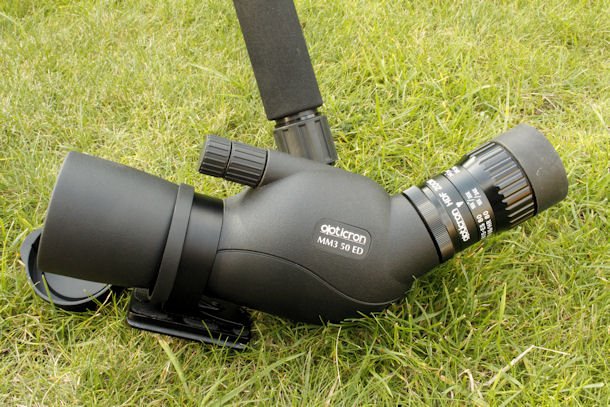
As some of you may be aware, I spend a lot of time on aeroplanes, working my way to exotic locations and then stumbling around, bleary-eyed, enjoying the natural wonders that this week’s destination has to offer. All this travelling means lots of packing and packing means compromise. Baggage allowance, airport security and lack of Sherpas force me consider carefully what I will need to bring and what can be dispensed with. I was intrigued then, when Corey handed me a stubby little device that turned out to be an Opticron MM3 50 ED Travelscope and asked for my thoughts.
My thoughts won’t cover too many tech specs (you can peruse these at the link above), but will focus on a user’s experience.
First of all I was struck by how small and light it was. As a travelscope, it was scoring points straight from the box. Including the eyepiece, it weighs just 800g and measures 28cms. It is robustly built with a 50mm objective lens and ED coating for all your anti-chromatic aberration needs.
It may be small, but it performed very well in good light conditions with good focus, crisp to the edges and quickly achieved with a dual focussing control. I was impressed by its ability to focus very closely at 2.5m and began to wonder about its capacity for digiscoping dragonflies.
I was given the angled body with a HDF 40862 (12-36X) eyepiece to play with and found that I was achieving fine detail, good contrast and colour across the zoom range.
As a piece of hand baggage, it certainly beats the bulkier and heavier scopes with big objective lenses and it has survived the rigours of a couple of trips in my hold-loaded suitcase, protected by its lightweight polycarbonate/alloy armour. More to the point, there is very little compromising or decision making required if I want to bring the MM3 away with me. Taking my big scope on a trip means deciding whether I will really need it and what I will leave behind to accommodate it.
Travelscopes are not a new concept and there are plenty available on the market. I am a Bushnell fan for example and enjoyed a morning with their Legend Ultra HD recently, but the MM3 50 ED is preferred for its lightness and it outlasts the pricier Nikon Fieldscope ED50 by having excellent eye relief for long spotting days.
We have established that I like the scope very much and that checking it will become an established part of my packing regimen, but I couldn’t help tinkering with it a bit.
Perhaps Opticron would be interested to take up my patent on the shade/hood which the MM3 sadly lacks. A miserable day in Mumbai dawned with wind and rain blowing towards me across Powai Lake (if I am to give the scope a fair test it needs to be able to perform in poor conditions as well as good, clear light). Without a hood to protect the objective lens from the rain, I had to postpone my digiscoping efforts on that occasion and was prompted to find a solution for next time.
The centre of gravity for the scope is aft of the collar and the eyepiece tips down if not adequately tightened on the tripod. Normally this would be an inconsequential issue, but when digiscoping equipment is attached, the added weight at the eyepiece end accentuates the problem and makes vertical alignment quite tricky.
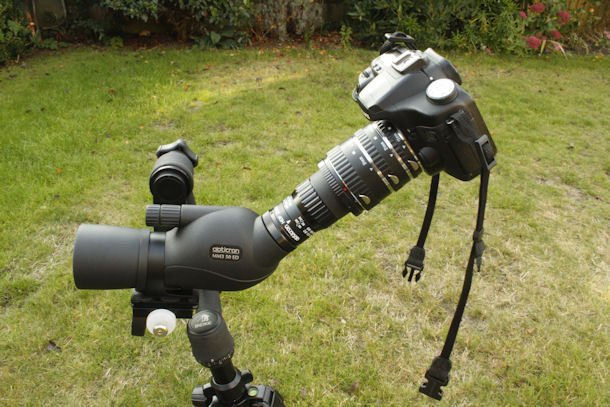
Not the recommended method, but I ordered the wrong adaptor
The adaptors for attaching cameras to the scope are well made and relatively cheap, but the literature does not make it clear that the 41112 Pushfit 49.5 adaptor is not suitable for DSLRs. The 40215 Telephotoadaptor (connected with a T-mount and the eyepiece removed) is the tool of choice for DSLRs.
With a T-mount (which push-fits onto the eye-piece) and a few old extension tubes it was possible to emulate the 40215 Telephotoadaptor, but the centre of gravity is very far back now and vertical alignment became the big issue. There are devices to extend a tripod plate which would correct the back-weight problem, but these are tripod head specific and I was unable to find one during the test.
I would like to leave you with the parting thought that the best scope available is the one that you have with you at the time. If you are travelling and are concious of weight, you may decide that your big 80mm scope is just too much to carry. In this instance, the MM3 50 ED is set to become a firm favourite.
…
Opticron kindly provided some of their equipment to 10,000 Birds for review. They are also an advertiser on the site as of the posting of this review. Neither their equipment nor their advertising influenced this review.
…



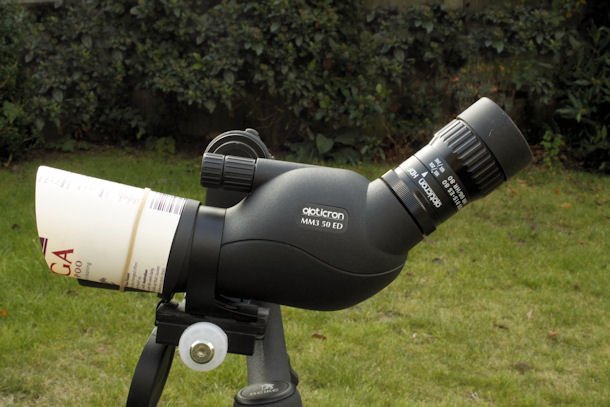






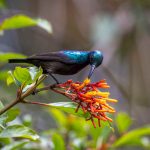


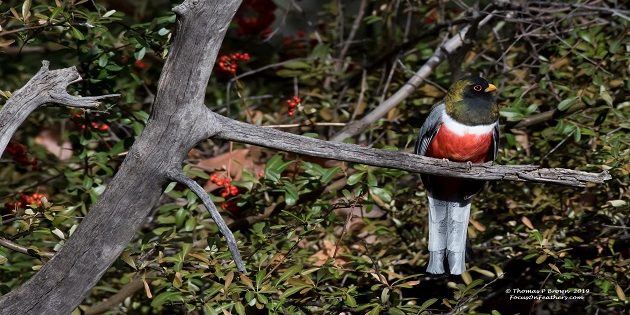

Leave a Comment